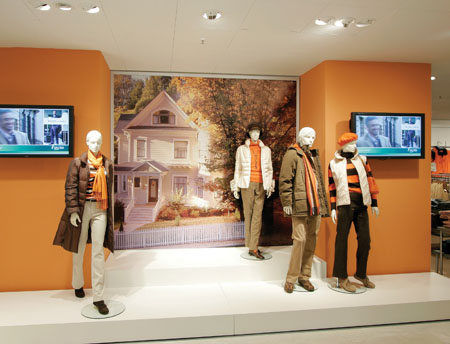

|
Номер журнала: Retail
Рубрика:
Summary

Light—the Engine of Trade
p.4
Technical progress and Internet access have changed the face of retail trade the world over. Product cycles are becoming shorter, while business development and competition are more dynamic. Now retailers must display striking individuality in order for customers to remember them longer.
A commercial enterprise’s corporate image is composed of many parts, including window design, commercial space, selection of goods, manner of product presentation and level of service. Lighting is an important factor for each of these parameters. The appearance of the illumination chosen by a retailer helps to emphasize the commercial venture’s individuality and lend a high profile to the brand.
Individually developed lighting is not only instrumental in enabling increase in sales, but also is an important characteristic of corporate design and style. Colour used as a way of standing out—-corporate colour—is becoming a major factor in retail success. The effective use of lighting in moving goods and in advertising helps to gain a key competitive advantage. The more exclusive the shop and its selection, the more stylish its lighting has to be. However, complete recipes for creating lighting systems do not exist. Treatments are as various as the choice of lamp and lighting equipment on the market. So when creating a new shop, it is always necessary to consult a lighting designer, an interior designer and a specialist in the design of retail space.
A Feeling of History
p.34
Shops located in spaces not originally designated for commerce are not a rarity. Here is a department store occupying a historical building almost 1,000 years old; judging by commercial practices, it is at least unusual. “Manufactum” occupies 950 square meters on the first floor of one of five buildings leading into the Munich complex, Alter Hoff. The foremost part of the space is clearly structured. It takes its expression from the suite of cross-vaulted spaces, which naturally divide the area into zones, while still leaving in place one of the interior’s main expressive elements.
The interior’s conception of lighting was created from the point of view of its outward perception. The designers viewed the store with the eyes of passersby, with the curiosity of those looking at the window lighting. As a result, with the help of light, a well-structured space was created, relaying precise information about the variety of selection and organisation of the store before the customer goes inside.
Manufactum’s other important principle of lighting is based on the very nature of its trademark and its direct appeal to an entire group of consumers—people who choose quality articles that recommend themselves. These qualities found expression in the overall organisation of the store’s lighted space—soft, comfortable, but confined by exact illumination that assists in making a connection between the customer and the product, such as the very shape of the light fixtures, specially developed for Manufactum by the Munich company, Pfarre Lighting Design.
_m.jpg)
LED’s in Jewelry Shop Windows
p.52
LED’s constitute a fairly new direction in the illumination of counters and display windows of stores. Bright, saturated light, long life, minimal heat output and low energy use will ensure their widespread use in fitting out stores for the near future. Jewelry requires a particular approach, in which accent lighting plays a primary role. Presently, jewelry shops most often install halogen lamps, which in many instances have negative effects on sensitive articles, heating them and altering their external appearance. LED’s do not have the drawbacks of traditional sources of light. The special character of their radiation permits them not only to illuminate jewels, but to give them full play, disclosing the depth of a stone’s colour and the shape of its setting.
Different coloured highlights of white LED’s are used for various settings, as well as for their combinations. For diamonds and their settings of white gold and platinum, a cold, white shade of light is best, while for red gold with a setting of synthetic diamonds (fianite) and coloured stones, warm white or a combination of warm white and cold white or neutral white work well.
LED lighting fixtures are equipped with differently shaped lenses, requiring a light ray and change in its direction. For spotlighting larger scale objects, single light fixtures with powerful LED’s, which distribute light in corners and in the window’s centre are employed. Strengthening the radiance and play of light on the edges of precious stones, LED’s present them more effectively.
|